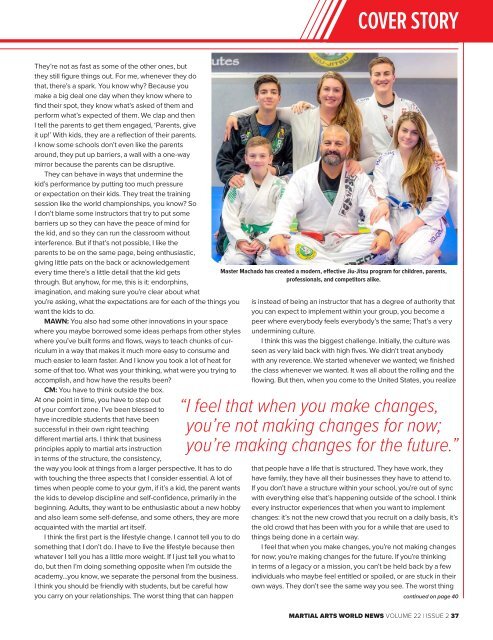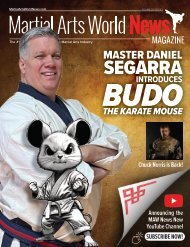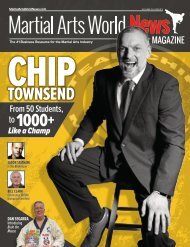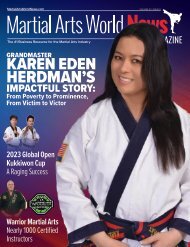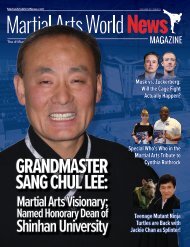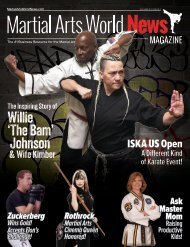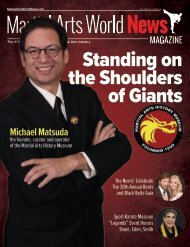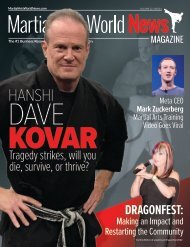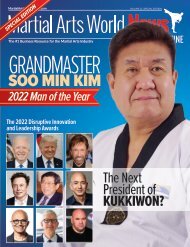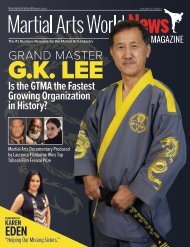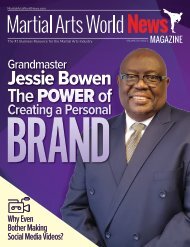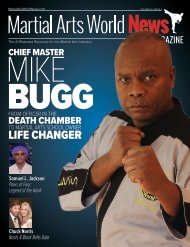Martial Arts World News Magazine - Volume 22 | Issue 2
The #1 Business Resource for the Martial Arts Industry
The #1 Business Resource for the Martial Arts Industry
Create successful ePaper yourself
Turn your PDF publications into a flip-book with our unique Google optimized e-Paper software.
COVER STORY<br />
They’re not as fast as some of the other ones, but<br />
they still figure things out. For me, whenever they do<br />
that, there’s a spark. You know why? Because you<br />
make a big deal one day when they know where to<br />
find their spot, they know what’s asked of them and<br />
perform what’s expected of them. We clap and then<br />
I tell the parents to get them engaged, ‘Parents, give<br />
it up!’ With kids, they are a reflection of their parents.<br />
I know some schools don’t even like the parents<br />
around, they put up barriers, a wall with a one-way<br />
mirror because the parents can be disruptive.<br />
They can behave in ways that undermine the<br />
kid’s performance by putting too much pressure<br />
or expectation on their kids. They treat the training<br />
session like the world championships, you know? So<br />
I don’t blame some instructors that try to put some<br />
barriers up so they can have the peace of mind for<br />
the kid, and so they can run the classroom without<br />
interference. But if that’s not possible, I like the<br />
parents to be on the same page, being enthusiastic,<br />
giving little pats on the back or acknowledgement<br />
every time there’s a little detail that the kid gets<br />
through. But anyhow, for me, this is it: endorphins,<br />
imagination, and making sure you’re clear about what<br />
you’re asking, what the expectations are for each of the things you<br />
want the kids to do.<br />
MAWN: You also had some other innovations in your space<br />
where you maybe borrowed some ideas perhaps from other styles<br />
where you’ve built forms and flows, ways to teach chunks of curriculum<br />
in a way that makes it much more easy to consume and<br />
much easier to learn faster. And I know you took a lot of heat for<br />
some of that too. What was your thinking, what were you trying to<br />
accomplish, and how have the results been?<br />
CM: You have to think outside the box.<br />
At one point in time, you have to step out<br />
of your comfort zone. I’ve been blessed to<br />
have incredible students that have been<br />
successful in their own right teaching<br />
different martial arts. I think that business<br />
principles apply to martial arts instruction<br />
in terms of the structure, the consistency,<br />
the way you look at things from a larger perspective. It has to do<br />
with touching the three aspects that I consider essential. A lot of<br />
times when people come to your gym, if it’s a kid, the parent wants<br />
the kids to develop discipline and self-confidence, primarily in the<br />
beginning. Adults, they want to be enthusiastic about a new hobby<br />
and also learn some self-defense, and some others, they are more<br />
acquainted with the martial art itself.<br />
I think the first part is the lifestyle change. I cannot tell you to do<br />
something that I don’t do. I have to live the lifestyle because then<br />
whatever I tell you has a little more weight. If I just tell you what to<br />
do, but then I’m doing something opposite when I’m outside the<br />
academy…you know, we separate the personal from the business.<br />
I think you should be friendly with students, but be careful how<br />
you carry on your relationships. The worst thing that can happen<br />
Master Machado has created a modern, effective Jiu-Jitsu program for children, parents,<br />
professionals, and competitors alike.<br />
is instead of being an instructor that has a degree of authority that<br />
you can expect to implement within your group, you become a<br />
peer where everybody feels everybody’s the same; That’s a very<br />
undermining culture.<br />
I think this was the biggest challenge. Initially, the culture was<br />
seen as very laid back with high fives. We didn’t treat anybody<br />
with any reverence. We started whenever we wanted; we finished<br />
the class whenever we wanted. It was all about the rolling and the<br />
flowing. But then, when you come to the United States, you realize<br />
“I feel that when you make changes,<br />
you’re not making changes for now;<br />
you’re making changes for the future.”<br />
that people have a life that is structured. They have work, they<br />
have family, they have all their businesses they have to attend to.<br />
If you don’t have a structure within your school, you’re out of sync<br />
with everything else that’s happening outside of the school. I think<br />
every instructor experiences that when you want to implement<br />
changes: it’s not the new crowd that you recruit on a daily basis, it’s<br />
the old crowd that has been with you for a while that are used to<br />
things being done in a certain way.<br />
I feel that when you make changes, you’re not making changes<br />
for now; you’re making changes for the future. If you’re thinking<br />
in terms of a legacy or a mission, you can’t be held back by a few<br />
individuals who maybe feel entitled or spoiled, or are stuck in their<br />
own ways. They don’t see the same way you see. The worst thing<br />
continued on page 40<br />
MARTIAL ARTS WORLD NEWS VOLUME <strong>22</strong> | ISSUE 2 37


